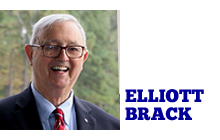By Elliott Brack, special to Statehouse Report | There were major political results in New York City this week, as citizens there held a primary to determine who will be the Democratic candidate for mayor. Weak Republican influence in New York poin ts to the eventual Democratic winner as the next mayor. The mayor will officially be decided in their General Election in November.
ts to the eventual Democratic winner as the next mayor. The mayor will officially be decided in their General Election in November.
The New York election is important for a new reason: Tuesday’s primary was the first with the city using “ranked choice voting.” Such a system is innovative. Its best feature is that it eliminates the election having to resort to a second vote, a runoff, to determine the winner. However, it may take two weeks, until all absentee ballots are in and counted, to find out who is to be the Democratic nominee for the post.
The ranked-choice tabulation only kicks in if no candidate gets 50 percent (plus one vote) in the election. (The leading candidate got 31 percent of the vote.) With 13 people seeking to win the New York mayorship, it was almost certain that no candidate would get 50 per cent of the vote, so ranked-choice is being used to pick the winner. (Ranked choice tabulations are computer-controlled and complicated; it may take several more tabulations or rankings to determine the winner.)
In a traditional two-person race, ranked-choice has no application. But in a primary such as in New York with 13 candidates, or similarly, in Georgia last year for the remainder of the term for the Isakson Senate seat, it eliminates a costly runoff.
 Here’s how the ranked choice works. Voters don’t just vote for a single person. They rank their top five choices for the office. When ranked choice counting reveals no majority winner, counting begins anew. The candidate in last place is eliminated. All ballots cast for that eliminated candidate are then reallocated to the No. 2 choices of those voters. The votes are then re-tallied and the candidate in last place is eliminated again. The process repeats until there are two candidates left, and the one with more votes wins.
Here’s how the ranked choice works. Voters don’t just vote for a single person. They rank their top five choices for the office. When ranked choice counting reveals no majority winner, counting begins anew. The candidate in last place is eliminated. All ballots cast for that eliminated candidate are then reallocated to the No. 2 choices of those voters. The votes are then re-tallied and the candidate in last place is eliminated again. The process repeats until there are two candidates left, and the one with more votes wins.
The major benefit, besides elimination of a runoff, is that the winner comes from support of a broad cross section of the voters. Candidates must therefore appeal to this larger audience, instead of relying on a narrow base of voters.
It also allows the people to vote (“support”) more than one candidate, basically selecting their choices in order according to which candidates appeal to them. Most voters often like more than one candidate, and this allows them to show that support, in ranking their top choice. By ranking, you can still have a voice in choosing the winner, though your top candidates may not be in the running.
The states of Maine and Alaska have used ranked choice voting, and some cities, including San Francisco and Minneapolis, have adopted this system. This year, Salt Lake City and 22 other Utah cities will use ranked-choice voting in the city elections in the fall.
Ranked choice is relatively new. But it’s been working in Australia, Ireland, New Zealand, Malta, Northern Ireland and Scotland. We’ll see if more of the United States considers this method of election.
The New York City primary voting was the largest single use of the ranked choice system. It could prove useful to be an effort which could be extended to other cities and states to improve elections.
- Longtime Georgia journalist Elliott Brack is editor and publisher of GwinnettForum.com, where this commentary first appeared. Have a comment? Send to: feedback@statehousereport.com.


